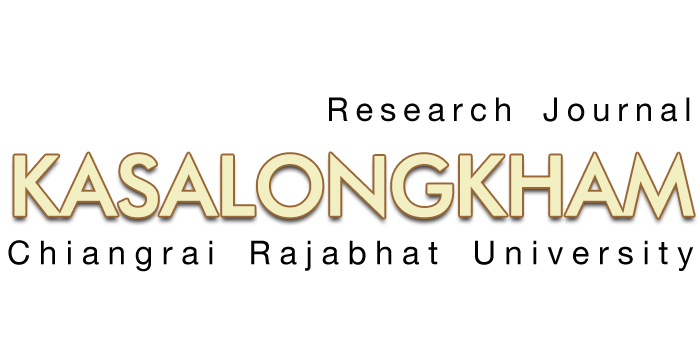The Khmu ethnic community's participatory solid waste management in Ban Wang Pha, Tha Kham Subdistrict, Wiang Kaen District, Chiang Rai Province
Keywords:
Management Participation, Solid Waste, Khamu EthnicAbstract
The purposes of this research were to study the conditions, factors, and guidelines for participatory waste management and distill the lessons of participatory waste management in the Khamu ethnic community of Baan Wang Pha, Tha Kham subdistrict, Wiang Kaen district, Chiang Rai Province. We conducted the research using a qualitative method, collecting data from household representatives and community committees. The research instruments used were SWOT and TOWS analyses, the CIPP model, interview structure, guided interviews, and focus groups. We analyzed the data through content analysis and synthesis, then compiled it into a descriptive research report. The research revealed that the Khamu ethnic communities in Baan Wang Pha, located in highland remote areas, face waste management challenges due to their lack of proper management and appropriate knowledge of solid waste management. The factors or conditions that contributed to the success of solid waste management in the communities, which were community leaders, village committees, health volunteers, strong women groups, villager cooperation, and the local government organization, supported the budget and solid waste management planning. To improve community waste management efficiency, there were using the 3R principles: reduce, reuse, recycle, and the five "5 Gor," such as group, fund, rules, activities, and committee.
References
Abdullah, N. K., Sakawi, Z., & Ismail, L. (2014). The Perception of the Langkawi Community on Solid Waste Management. Current World Environment, 9(2), 237-243.
Chudok, S., & Sa-nguanpauk, K. (2021). Community Participation in Waste Management: A Case of Kong Thanu Subdistrict Administrative Organization, Mueang District,
Lop Buri Province. Humanities and Social Science Journal, Ubon Ratchathani University, 12(2), 28 – 48.
Department of Local Administration. (2018). Community solid waste management action plan “Clean Province” for the year 2018 according to the annual Pracharat
guidelines. Ministry of Interior.
Department of Local Administration. (2019). Community solid waste management action plan “Clean Province” for the year 2019. https://www.dla.go.th/upload/document/type2/2018/11/20831_1_1542678942912.pdf
Donsom, J., & Ruchuwararak, P. (2022). Community Waste Management Based on Cultural Capital of Isan Way: A Case Study of Ban Phue Municipality, Nong Ruea District, Khon Kaen Province. Journal of Humanities & Social Sciences (JHUSOC), 20(2), 157-178.
Gerdmeesuk, P. (2017). Participation in the management of community banks refuse Wat Puranawath Thawi Watthana Bangkok (Phase 1). ACADEMIC JOURNAL BANGKOKTHONBURI UNIVERSITY, 6(2), 92- 101.
Gufur, A., Selintung, A., Rahim, M. R., & Patanduk, J. (2017). Community-Based Solid Waste Management Models in the Heterogeneus Region of Palu. International Journal of Civil Engineering and Technology (IJCIET), 8(10), 1181–1190.
Indrianti, N. (2016). Community-based Solid Waste Bank Model for Sustainable Education. Social and Behavioral Sciences, 224(2016), 158-166.
Kiriram, P. & Srikuta, P. (2018). Capacity Building of Community Leaders for Waste Management: A Case Study in a Community in Muang District, Nakhon Ratchasima Province. The Office of Disease Prevention and Control 9th. Nakhon Ratchasima Journal, 25(1), 64 - 73.
Pollution Control Department. (2016). Master Plan of the Country’s Solid Waste Management (2016–2021). Active Print Company Limited. http://www.pcd.go.th
Pollution Control Department. (2019a). Report on the pollution situation in Thailand in 2020. Ministry of Natural Resources and Environment. Style Creative House Company Limited.
Pollution Control Department. (2019b). Information on the country's solid waste situation. Community solid waste management information system.
https://thaimsw.pcd.go.th/service/api/report-country/export?year=2562
Pollution Control Department. (2021). Thailand State of Pollution Report 2020. Ministry of Natural Resources and Environment. Style Creative House Company Limited.
Pollution Control Department. (2022). Thailand State of Pollution Report 2021. Ministry of Natural Resources and Environment. Style Creative House Company Limited.
Pollution Control Department. (2023). Thailand State of Pollution Report 2022. Ministry of Natural Resources and Environment. Style Creative House Company Limited.
Singhirunnusorn, W., Donlakorn, K., & Kaewhanim, W. (2012). Contextual Factors Influencing Household Recycling Behaviours: A Case of Waste Bank Project in Mahasarakham Municipality. Social and Behavioral Scinces, 36(2012), 688-697.
Srimongkol, S. & Pisuthidhammaporn, Prakru. (2022). Participation of Population in Solid Waste Management in Na-O Subdistrict Municipality, Loei Province. Integrated Social Science Journal, 2(5). 17- 23.
Srisamran, S., Siriwat, S., Wangkahart, A., & Ponrachom, C. (2022). Behaviors and Causal Factors in Solid Waste Management of Local People in the Community. Research and Development Health System Journal, 15(2), 46- 59.
Srisontisuk, S., Aimimtham, S., Buasri, M., Wanong, M., Saengkaew, A., Yang, W., Sengonkeo, P. & Yanpaisan, N. (2020). The Roles of Sub District Administration Organization in Sustainable Waste Management in The Local Communities with The Case Study Of Khu Mueang Sub District Administration Organization, Nong Bua Daeng District, Chaiyaphum Province. RAJABHAT CHIANG MAI RESEARCH JOURNAL, 21(2), 112-127.
Stufflebeam, D. L. (2007). CIPP evaluation model checklist. https://wmich.edu/sites/default/files/attachments/u350/2014/cippchecklist_mar07.pdf

Downloads
Published
How to Cite
Issue
Section
License
Copyright (c) 2024 KASALONGKHAM RESEARCH JOURNAL, Chiang Rai Rajabhat University

This work is licensed under a Creative Commons Attribution-NonCommercial-NoDerivatives 4.0 International License.

 e-ISSN:
e-ISSN: 

